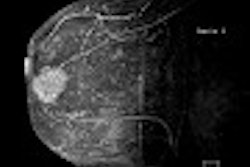Results of first-pass MR myocardial perfusion for assessment of microvascular dysfunction correlate with angiographic surrogates, which makes the case for the less invasive MR technique, according to researchers at Brigham and Women’s Hospital in Boston.
Research fellow Dr. Nagesh Anavekar said "using perfusion MR is a simple and noninvasive way to assess microvascular damage. Moreover, because this is a noninvasive technique it can be used in a serial fashion to assess the efficacy of therapy." Anavekar presented his group’s results at the 2003 American College of Cardiology meeting in Chicago earlier this month.
Typically, microvascular dysfunction in acute myocardial infarction following percutaneous coronary intervention (PCI) is assessed using a TIMI frame count (cTFC) and myocardial blush grade (MBG). Anavekar and colleagues assessed 28 patients with first-pass gadolinium MRI perfusion for evaluation of microvascular dysfunction, but he presented results from just the first 25 patients who underwent imaging within 24 hours of PCI for first acute MI. The results were compared to angiographic measures.
Artery-specific myocardial perfusion was determined (qualitative and quantitative) by two readers blinded to the size of the defect (i.e., percentage of left ventricular mass; score 0 = none to 3 = large) and to its severity.
The average age of the patients was 59. Average creatine kinase was 617 mg/dL, and the average left ventricular ejection fraction was 53%. PCI achieved TIMI 3 flow in 85%, and reduced the percent of stenosis from an average of 91% to 16%.
Minimal luminal diameter rose from an average of 0.27 mm to 2.69 mm, while minimal diameter increased from 0.27 ± 0.46 to 2.69 ± 0.57 mm, and corrected TIMI time frame improved from 67 ± 28 to 36 ± 15. Myocardial blush grade fell from 2.0 ± 0.9 to 1.0 ± 0.9.
Anavekar said the size of left ventricular mass and severity (contrast-to-noise 23.0 ± 20) of microvascular dysfunction by MRI correlated with cTFC (r2= 0.72, p<0.0001), MBG (r2= 0.75, p<0.0001), post TIMI antegrade flow (r2= -0.48, p=0.01) and angiographic no-reflow (r2= 0.81, p<0.0001).
Moreover, Anaveker pointed out that by itself, qualitative scoring of defect size and severity correlated with cTFC (r2=0.61, p=0.001) and MBG (r2=0.57, p=0.002).
By Peggy PeckAuntMinnie.com contributing writer
April 14, 2003
Related Reading
PET may overpredict myocardial recovery compared with MRI, March 11, 2003
MRI offers comprehensive approach to assessing myocarditis, March 3, 2003
MRI better than SPECT for predicting myocardial viability soon after MI, February 19, 2003
Cardiac MRI outdoes SPECT in spotting microinfarcts, February 14, 2003
Copyright © 2003 AuntMinnie.com



.fFmgij6Hin.png?auto=compress%2Cformat&fit=crop&h=100&q=70&w=100)



.fFmgij6Hin.png?auto=compress%2Cformat&fit=crop&h=167&q=70&w=250)











